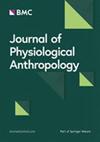How staying in a gymnasium affects sleep and bed climate in children
IF 3.1
4区 医学
Q1 Social Sciences
引用次数: 0
Abstract
We investigated the relationship between sleep, ambient climate, and bed climate in school-aged children during a one-night stay in a simulated shelter in a gymnasium to demonstrate the effect of ambient climate, and bed climate on sleep. We obtained measurements during a one-night stay in a school gymnasium (C), days before C (BC), on the day after (A1), and on the second day after C (A2) in 13 healthy school-aged children during summer. Sleep was evaluated using an actigraph, and the temperature and humidity of the bedrooms in the participants’ homes and in the gymnasium were monitored for 3 days before and after C. The bed climate of the chest and foot areas was measured for two nights before and after C. The participants were asked to report on their subjective sleep estimations and thermal sensations two nights before and after C. The ambient temperature in C was significantly higher than that in BC at the initial 180 min, while it significantly decreased compared to A1 and A2 in the last 100 min. The ambient humidity was significantly higher in both C and BC compared to A1 and A2. The sleep efficiency index decreased significantly in C (43±4.8%) compared to other conditions. Sleep time was significantly shorter in C than in other conditions during the initial 195 min. The increase in the bed climate temperature of the chest area in C was significantly delayed compared to that in the other conditions, around the initial 30 min after the lights were off. Subjective estimation revealed that in C, 85% of the participants were out of their sleeping bag at sleep onset, and their sleep was disturbed by heat (77%). Our study revealed that the disturbed sleep patterns observed with children in a simulated shelter may be related to a delayed increase in bed climate temperature in the chest area. This delayed increase could be related to the children not entering the sleeping bag and a delayed chest skin temperature increase during the sleep onset period.健身房如何影响儿童的睡眠和床的温度
我们调查了学龄儿童在体育馆模拟避难所中停留一晚期间睡眠、环境气候和床铺气候之间的关系,以证明环境气候和床铺气候对睡眠的影响。我们在暑期对 13 名健康学龄儿童在学校体育馆(C)、C 前几天(BC)、C 后一天(A1)和 C 后第二天(A2)的一夜住宿进行了测量。使用动觉仪对睡眠情况进行了评估,并监测了 C 前后 3 天参与者家中卧室和体育馆的温度和湿度,还测量了 C 前后两晚胸部和脚部的床温。与 A1 和 A2 相比,C 和 BC 的环境湿度都明显较高。与其他条件相比,C 的睡眠效率指数(43±4.8%)明显下降。在最初的 195 分钟内,C 条件下的睡眠时间明显短于其他条件。在熄灯后的最初 30 分钟左右,与其他条件相比,C 条件下胸部区域的床温上升明显延迟。主观估计显示,在 C 条件下,85% 的参与者在睡眠开始时离开睡袋,他们的睡眠受到热量的干扰(77%)。我们的研究表明,在模拟避难所中观察到的儿童睡眠模式紊乱可能与胸部区域床气候温度的延迟上升有关。这种延迟上升可能与儿童没有进入睡袋以及睡眠开始期间胸部皮肤温度延迟上升有关。
本文章由计算机程序翻译,如有差异,请以英文原文为准。
求助全文
约1分钟内获得全文
求助全文
来源期刊

Journal of Physiological Anthropology
Social Sciences-Human Factors and Ergonomics
CiteScore
4.80
自引率
6.50%
发文量
39
审稿时长
>12 weeks
期刊介绍:
Journal of Physiological Anthropology (JPA) is an open access, peer-reviewed journal that publishes research on the physiological functions of modern mankind, with an emphasis on the physical and bio-cultural effects on human adaptability to the current environment.
The objective of JPA is to evaluate physiological adaptations to modern living environments, and to publish research from different scientific fields concerned with environmental impact on human life.
Topic areas include, but are not limited to:
environmental physiology
bio-cultural environment
living environment
epigenetic adaptation
development and growth
age and sex differences
nutrition and morphology
physical fitness and health
Journal of Physiological Anthropology is the official journal of the Japan Society of Physiological Anthropology.
 求助内容:
求助内容: 应助结果提醒方式:
应助结果提醒方式:


